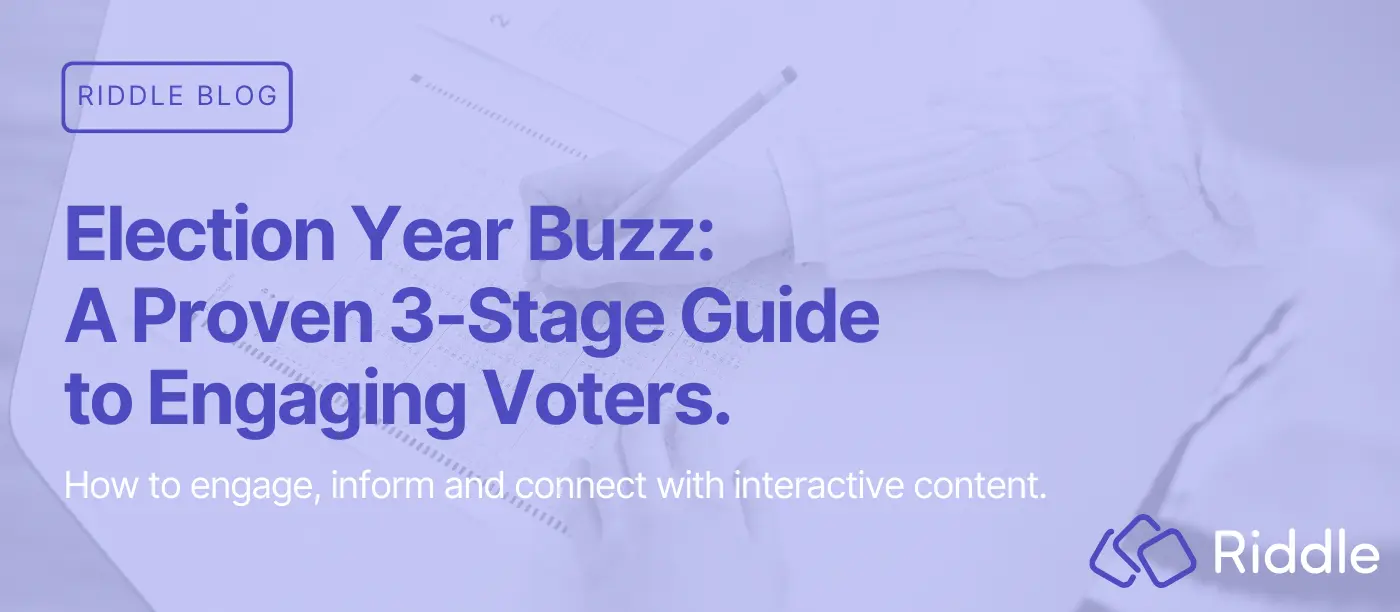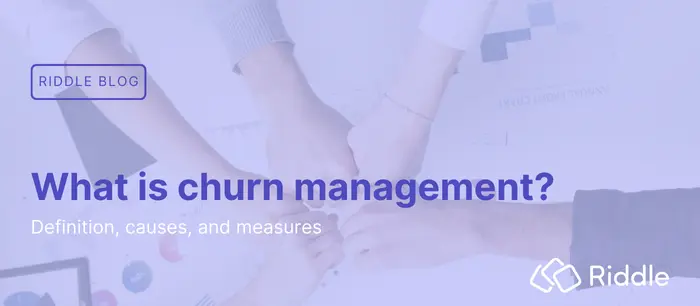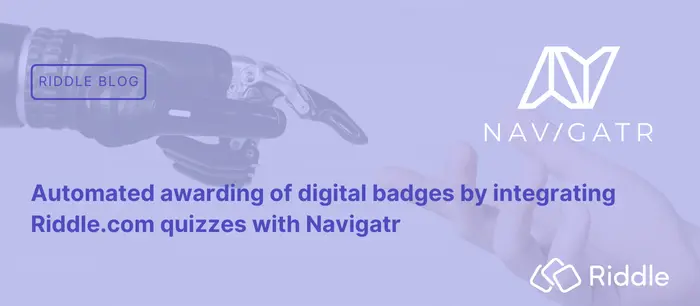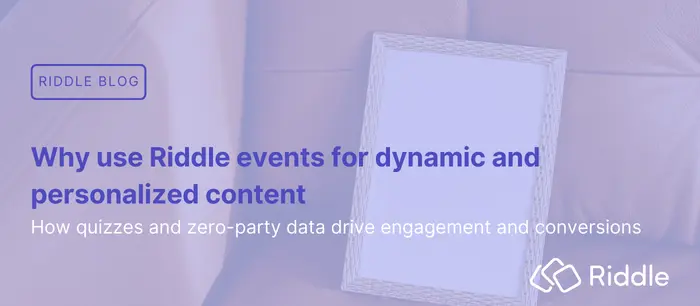How to engage, inform, and connect with voters during the election year with interactive content.
Keeping your audience engaged is crucial in the fast-paced world of digital media, especially during significant events like the upcoming U.S. presidential elections. Publishers need innovative ways to capture and retain audience attention during a 24/7 news cycle. One effective strategy is leveraging interactive content such as quizzes, polls, and predictors. In this blog post, we’ll explore how you can use these interactive tools to engage your audience before, during, and after the election. Our Quiz Marketing Experts have written a guide on how you can get started within 3 steps.
What is interactive content?
In a nutshell, interactive content is any online mechanism asking the audience to participate directly. Most content you find online will be static – where visitors will passively read it and then move on.
By contrast, interactive content turns passive readers into active participants – by asking them to vote, take an online quiz, answer a survey, and more.
The three (interactive content) stages of an election cycle
When using interactive content for election coverage, timing is everything. Let’s break it down into three stages: before, during, and after the election.
- Before election day: Ramp up the excitement by rolling out quizzes and polls that gauge audience predictions and preferences. It’s all about building anticipation and getting folks talking about the upcoming showdown.
- During the voting: Hold your audience’s attention with real-time updates and shorter, ‘quick hit’ content like polls (“Who’s going to win tonight?”) or predictors (“How many electoral collect votes will the winner receive?”). Let people be political armchair analysts and make their own predictions – it’s like hosting a virtual election night party!
- After the election: Once the dust settles, you can keep the conversation alive with post-election polls (“How well do you think the winner will do in office?”) and quizzes that dive deep into the elected Head of State’s policy positions and goals for their term in office.
Using this three-stage approach, you can use interactive content to keep your audience engaged from start to finish of any election.
(1) Before the election: build anticipation and engage.
As an election draws near, ramping up excitement and anticipation is essential. You can roll out quizzes and polls that intrigue, educate, and inspire your audience.
Our team of quiz experts created this list of interactive content concepts to help you get started. Don’t use these titles as is. Consider them a starting point for best results – you should customize each idea to make it your own.
Online quizzes
You should ask 6-8 questions to test your audience’s knowledge, each with right or wrong answers.
- “Election IQ test: How well do you know Party A and Party B?”
- “Presidential pop quiz: The ultimate election trivia challenge”
- “Election Facts or Fiction: Can you spot the lies?”
- “Election Essentials: How well do you know the process?”
Example: build quizzes to spread the messages of your candidates
We have created a sample quiz with a fictitious candidate who specializes in environmental issues.
Depending on the answer, the quiz takers are shown a different video message containing a statement on the relevant topic. In this way, arguments can be presented that are fact-based and convincing and prove the authenticity of climate change, for example.
Below, you can see a possible branching logic for how to build such quizzes. Depending on the answer, various contents can be offered to the quiz takers. In our example, we have subdivided how customers perceive the impact of gas emissions. Based on this, they are shown different explanatory videos and facts about the impact of the greenhouse effect (high impact / low impact).
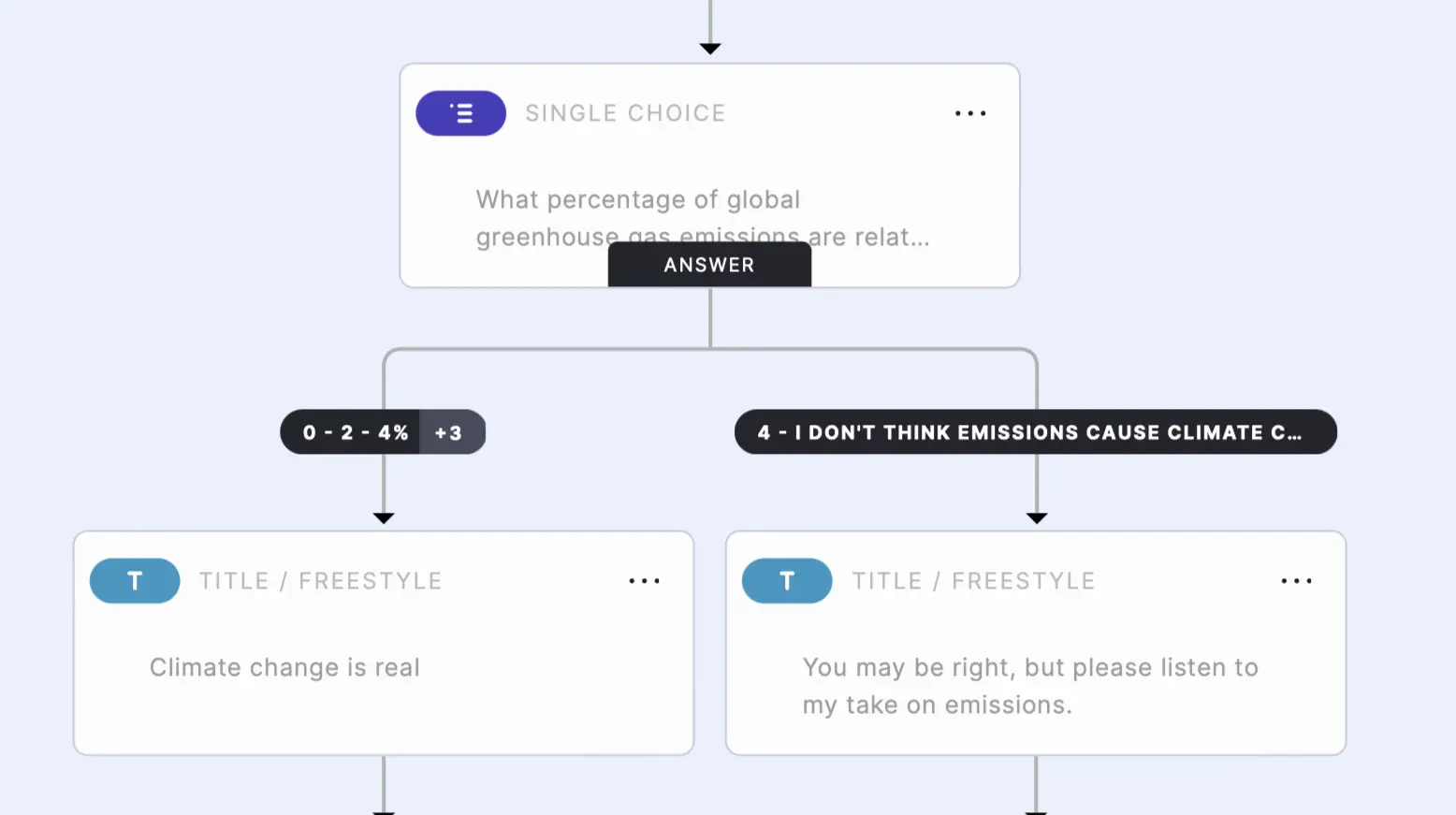
Personality tests
Election-oriented personality quizzes can be powerful election tools, helping your users choose the right candidate that matches their personal beliefs.
Personality tests are always popular because each user gets a result based on their own answers. We recommend incorporating 6-8 questions into your personality test, with 3-4 possible outcomes:
- “Are you more liberal or conservative? Take our quiz to find out!”
- “Pick the Head of State: Should you vote for Candidate A or Candidate B?”
- “Party A or Party B – which really reflects your TRUE values?”
- “Who should you actually vote for in this presidential election?”
Polls, survey, and predictors
People love to give their opinions about a political election. We recommend you plan a series of online polls, predictors, and other formats in the run-up to election day. Easy to create and generating high engagement rates, you can have interactive content up on your site in minutes:
- “Candidate A or B – who’s going to win the 2024 presidential election?”
- “What are the top 3 election issues for you?”
- “What factors will influence your voting decision the most?”
- “Do you plan to participate in early voting or vote on Election Day?”
(2) During the elections: keep it short to hold the audience’s attention.
Once Election Day arrives, it’s time to hold your audience’s attention with real-time updates and quick-hit interactive content.
You should shift from personality tests and quizzes and focus on shorter formats like polls or predictors asking questions like “Who’s going to win tonight?” to give your coverage a sense of urgency.
By providing a stream of opportunities for audience engagement, you can create a virtual election night party atmosphere, letting everyone participate in the excitement of electing a president.
Polls and predictors:
- “Who do you think will win the presidency tonight?”
- “How confident are you about the security of the election results?”
- “Gut check: How are you feeling right now about the election?”
Example: engage voters with score predictors
Our quiz experts have built a score predictor to engage voters during the upcoming presidential elections in the United States. As you know, these can be created in a matter of minutes, and playfully encourage your quiz takers to share their results with their friends.
(3) After the elections: sustain engagement with the voters.
The conversation doesn’t have to end after the dust settles and the winners are declared. Keep the momentum going by conducting post-election polls and quizzes that delve deeper into the implications of the results.
You could include questions like “How well do you think the winner will do in office?” or run quizzes about the new Head of State’s first 30 days in office to let your audience continue to engage with the outcome and its potential impact on the future.
Online quizzes
Short, punchy quizzes that test your users’ current affairs knowledge and last around three minutes will work well here. As previously mentioned, 6-8 questions is a good target, with 3-4 possible results (from people who score poorly to people who do well):
- “Beyond the ballot: A quiz on post-election political realities.”
- “Early 30: What do you really know about the President’s first month in office?”
- “Presidential primer: What happens in the first 30 days?”
- “From election to action: A quiz on the Prime Minister’s initial agenda.”
Polls, surveys, and predictors
Just because the election is over, it doesn’t mean your audience won’t have strong opinions. We recommend helping your visitors take stock of the election’s afterglow with insightful polls:
- “New President, New Poll: What’s Your Take?”
- “30 Days In: How’s the Prime Minister Doing?”
- “How happy (or horrified) are you about the new administration?”
- “Election fallout: What’s your biggest worry?”
Bonus: Poll and quiz results can fuel follow-up content
Your editors and journalists can use your audience’s feedback to power insightful follow-up articles:
- 56% of your audience think Candidate A will win? Write about it.
- 67% think presidents can be under 35? Write about that, too.
- Just 44% know how the Electoral College works in the United States? It is time for an analysis piece about the American education system.
Covering elections: your opportunity to engage, inform, and connect voters during the election year with interactive content.
Wrapping things up, interactive content like quizzes, polls, and surveys before, during, and after political elections is a winning strategy for you and other publishers. These tools keep your audience engaged, spark conversations and offer valuable insights into voter sentiment for your writers.
Every stage of the election requires a different approach.
- Before the big day, quizzes and polls excite people and help measure the political pulse.
- During the election frenzy, real-time updates and quick polls make everyone feel like they’re part of the action.
- After things calm down, post-election surveys keep the dialogue going, allowing people to reflect and share their views on the outcome.
By tapping into the power of interactive content, publishers can impact how people engage with the democratic process, all while keeping things fun and informative.
Further reading
100+ ideas for interactive content: https://politicalmarketer.com/interactive-content-examples-for-elections/
Digital Battlegrounds – how media and technology are shaping elections: https://campaigninnovation.org/research/digital-battlegrounds-how-new-media-and-technology-are-shaping-u-s-elections
